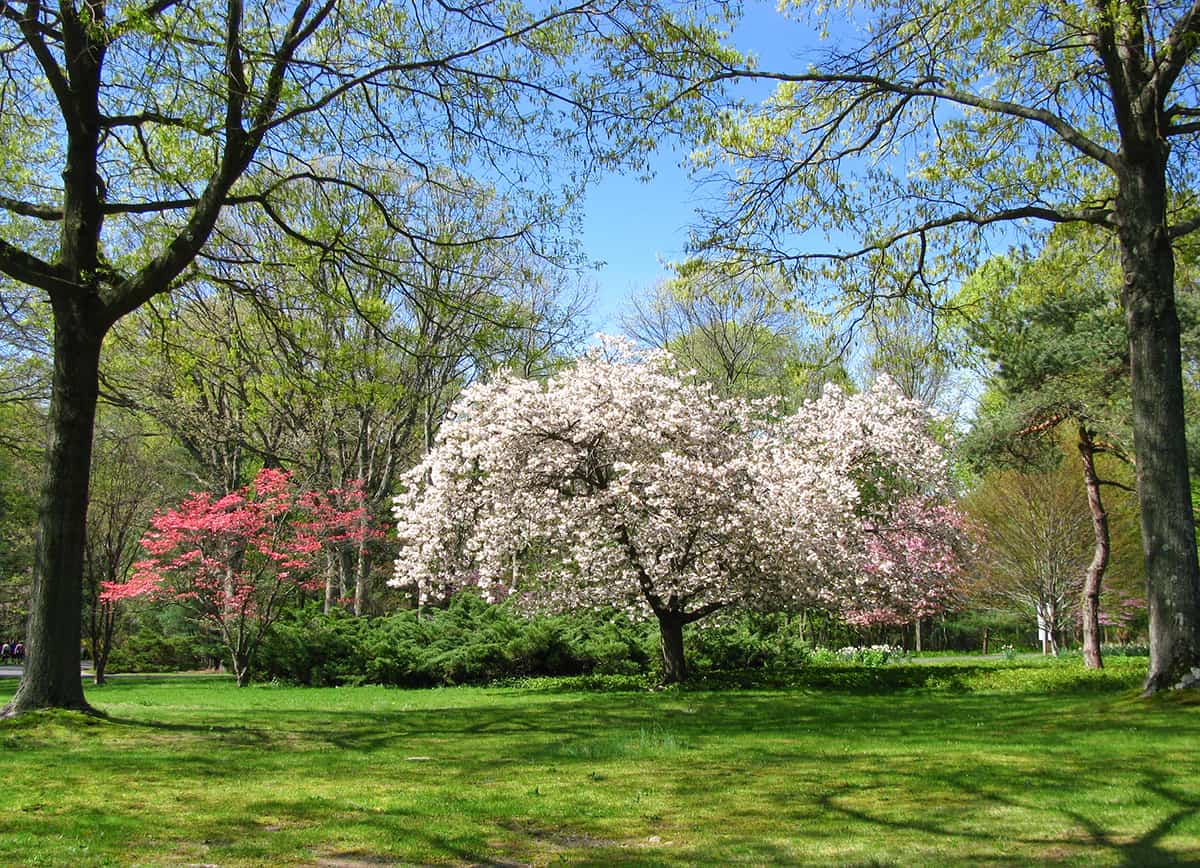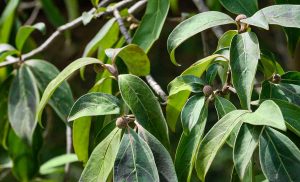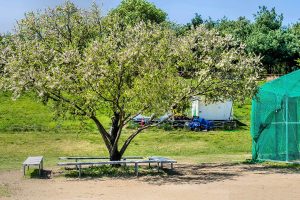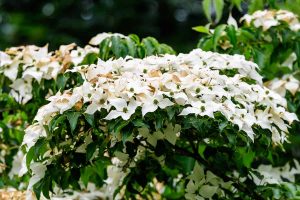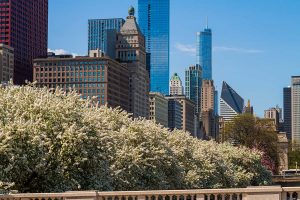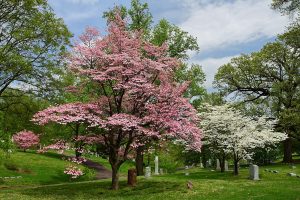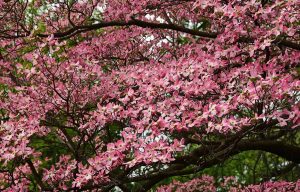Dogwood trees are deciduous, flowering trees that add interest to the landscape throughout the year. They are favored among gardeners for their decorative qualities and the fact that they are very easy to care for.
Here we share everything you need to know about dogwood trees, including different types of dogwood trees, how to identify dogwood trees, and how to care for them. Read on for the ultimate guide to dogwoods.
Table of Contents
Types of Dogwood Trees
White Dogwood
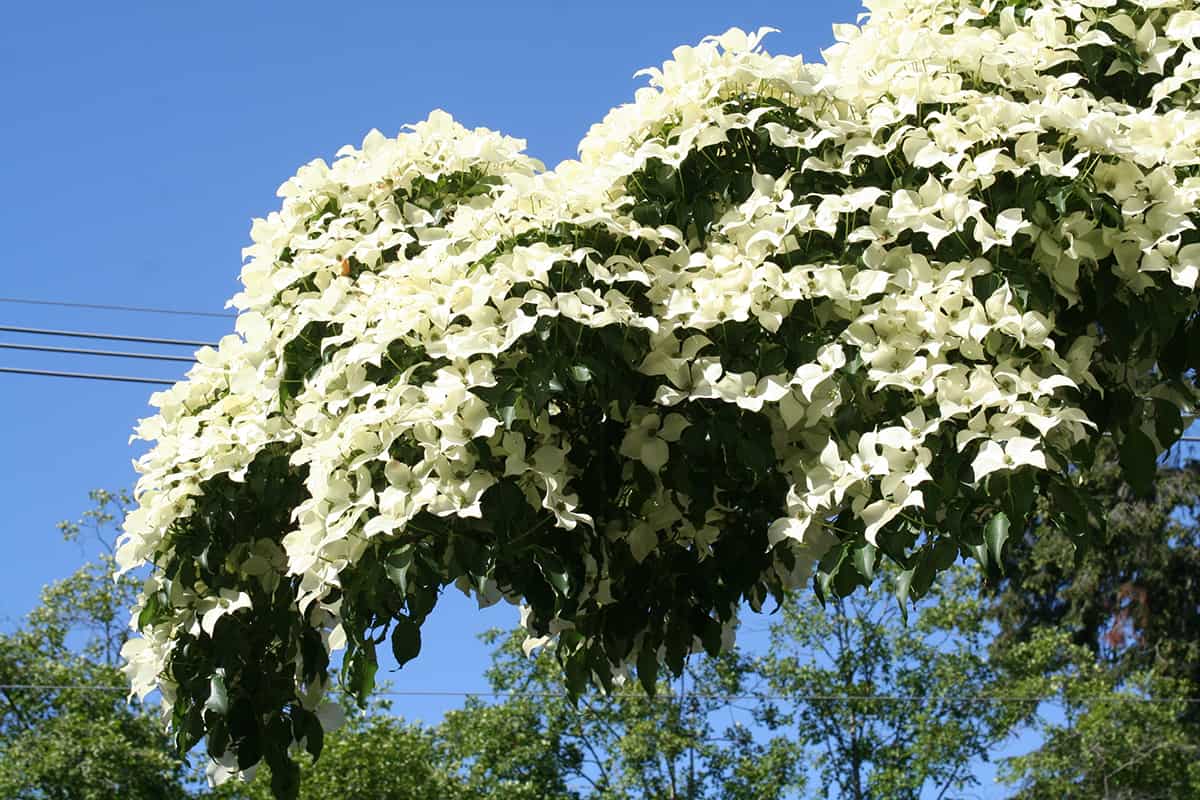
- Botanical name: Cornus alba
- Common names: White Dogwood, White Flowering Dogwood, Flowering Dogwood, Siberian Dogwood, Tartarian Dogwood, Red-Barked Dogwood
- Plant family: Cornaceae
- USDA hardiness zone: 2 – 7
- Mature height: 4 to 10 feet
- Mature spread: 4 to 10 feet
The White Dogwood is a medium-sized shrub that is known for its brightly colored winter stems. It also produces attractive blue-gray berries in the summer and can have variegated foliage.
Pagoda Dogwood
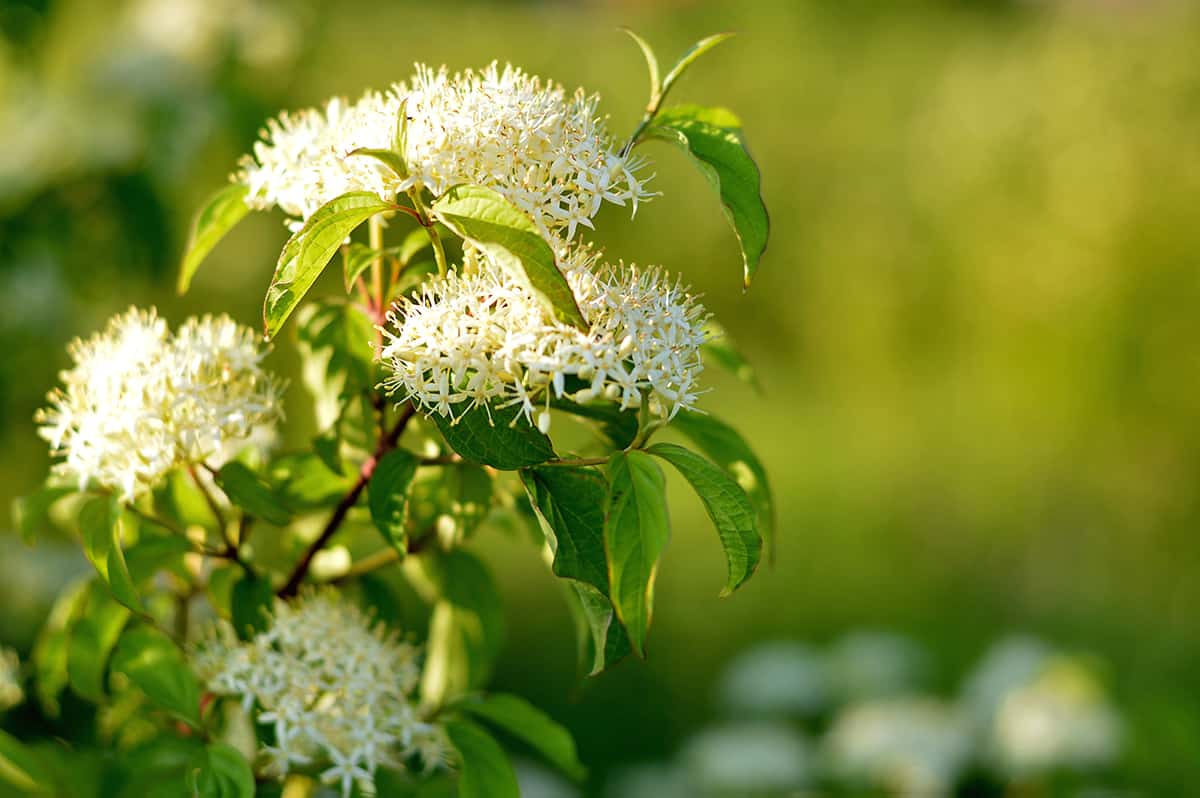
- Botanical name: Cornus alternifolia
- Common names: Pagoda Dogwood, Alternate Leaf Dogwood
- Plant family: Cornaceae
- USDA hardiness zone: 4 – 8
- Mature height: 15 to 25 feet
- Mature spread: 20 to 30 feet
The Pagoda Dogwood can be grown as a small tree or a large shrub. It produces horizontal, layered branches which are purple when young and clothed in dark green alternate leaves through spring and summer.
Pink Dogwood
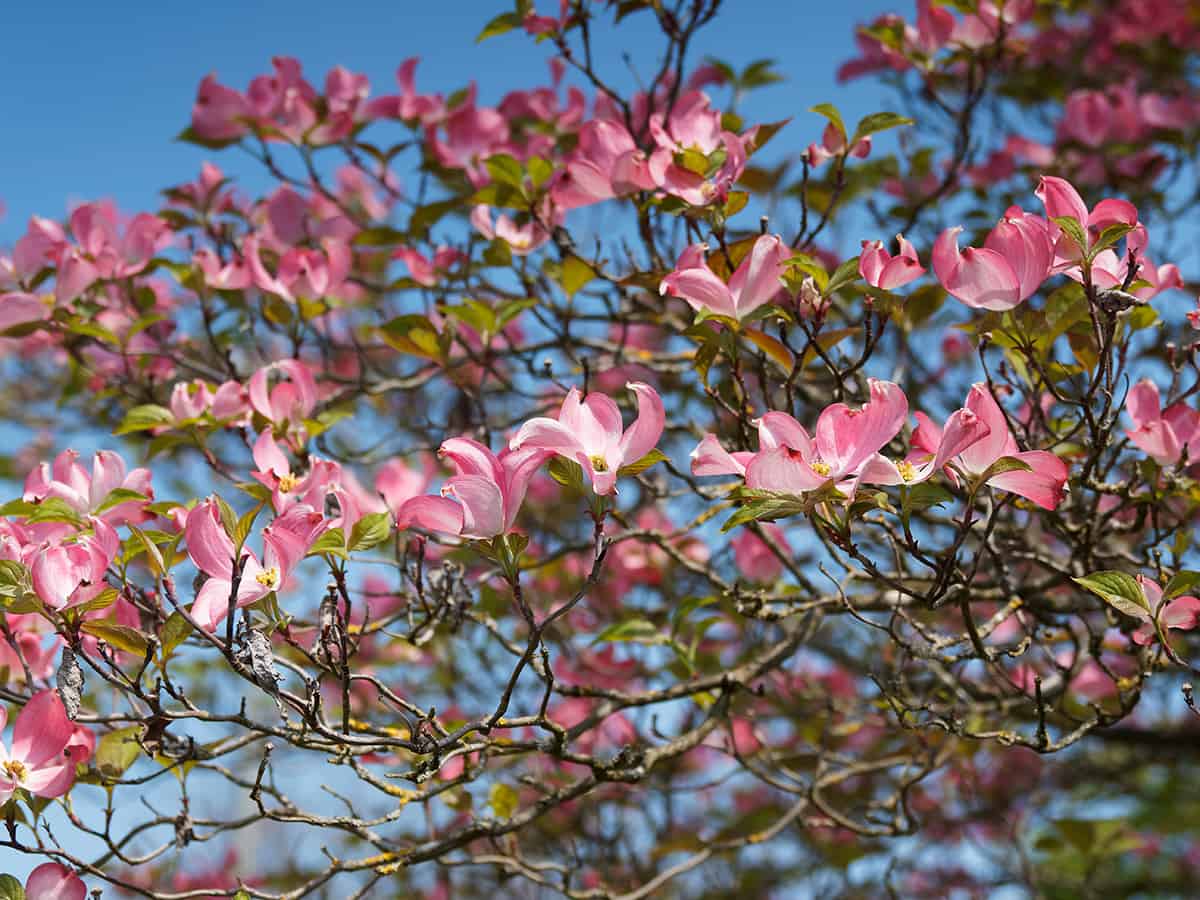
- Botanical name: Cornus florida f. rubra
- Common names: Pink Dogwood, Pink Flowering Dogwood, Flowering Dogwood, Eastern Flowering Dogwood, North American Green Osier
- Plant family: Cornaceae
- USDA hardiness zone: 5 – 9
- Mature height: 15 to 30 feet
- Mature spread: 15 to 30 feet
Pink Dogwood is a variety of flowering dogwood that produces pink flowers in varying shades, and these are followed by pink fruits.
Flowering Dogwood
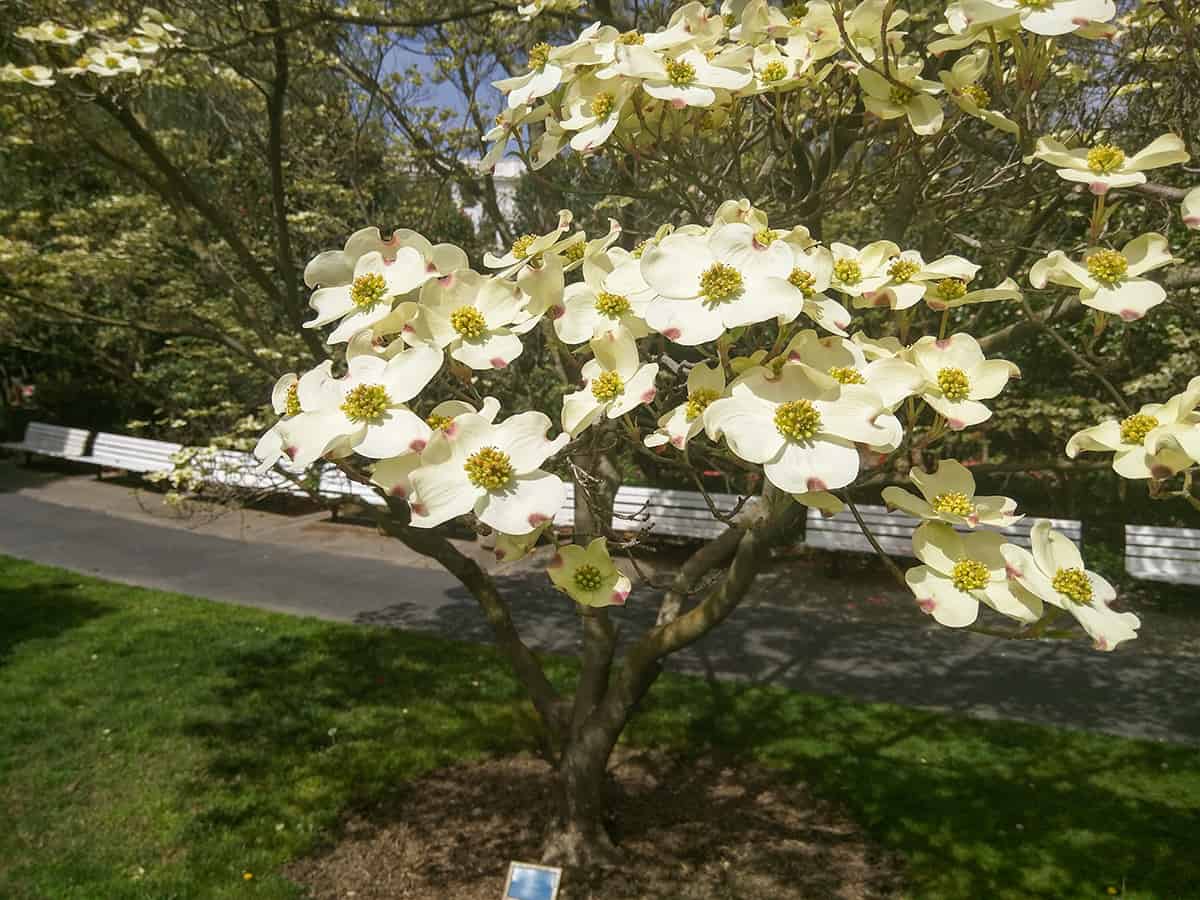
- Botanical name: Cornus florida
- Common names: Flowering Dogwood, Common Flowering Dogwood, Eastern Flowering Dogwood
- Plant family: Cornaceae
- USDA hardiness zone: 5 – 9
- Mature height: 15 to 30 feet
- Mature spread: 15 to 30 feet
The Flowering Dogwood can be grown as a large shrub or a small tree. It flowers in abundance in late spring, with blooms that can measure up to 4 inches across.
Japanese Dogwood
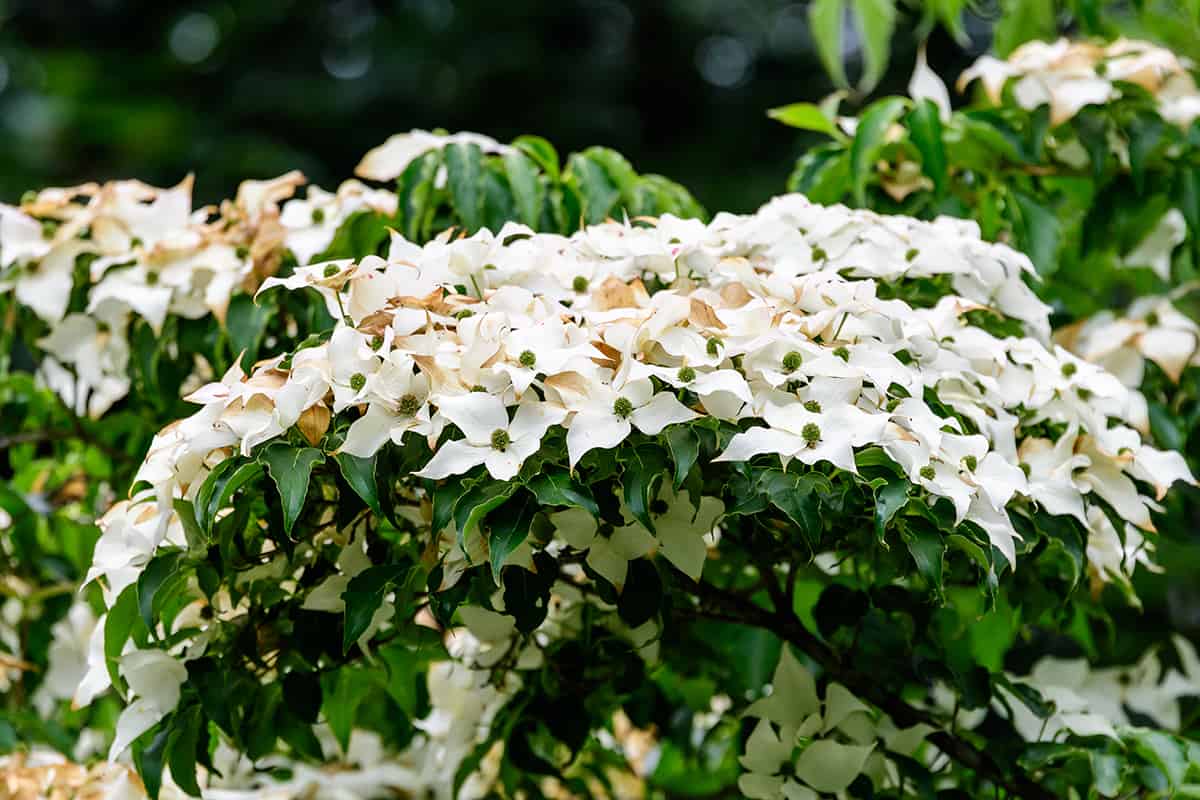
- Botanical name: Cornus kousa
- Common names: Japanese Dogwood, Japanese Flowering Dogwood, Flowering Dogwood, Kousa Dogwood, Cornus Japonica, Chinese Dogwood, Japanese Strawberry Tree
- Plant family: Cornaceae
- USDA hardiness zone: 5 – 8
- Mature height: 15 to 30 feet
- Mature spread: 15 to 30 feet
Japanese Dogwood can be grown as a large multi-stemmed shrub or a small, flowering tree. The flowers are white and develop into pink-red fruits.
Pacific Dogwood
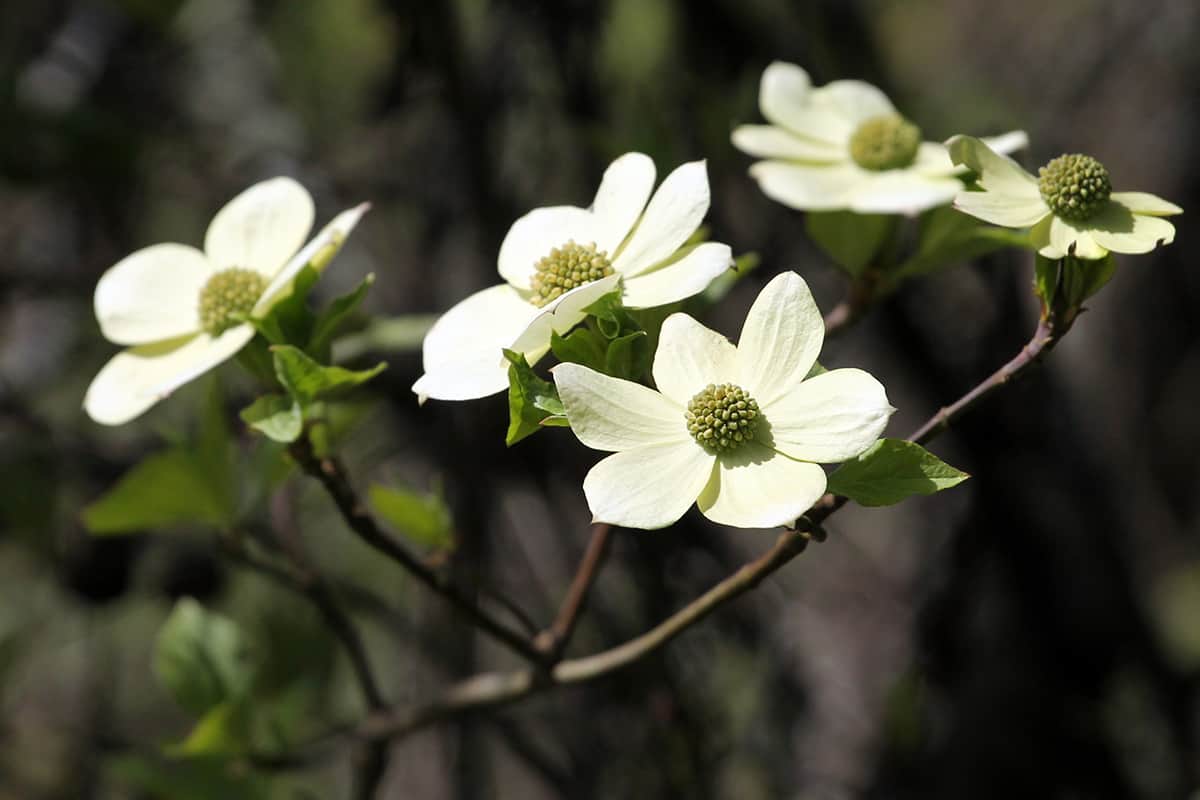
- Botanical name: Cornus nuttallii
- Common names: Pacific Flowering Dogwood, Pacific Dogwood, Mountain Dogwood
- Plant family: Cornaceae
- USDA hardiness zone: 7 – 9
- Mature height: 15 to 40 feet
- Mature spread: 10 to 25 feet
This is a large deciduous tree growing up to 40 feet. It flowers profusely with white or pink blooms from mid-spring through to mid-summer.
Gray Dogwood
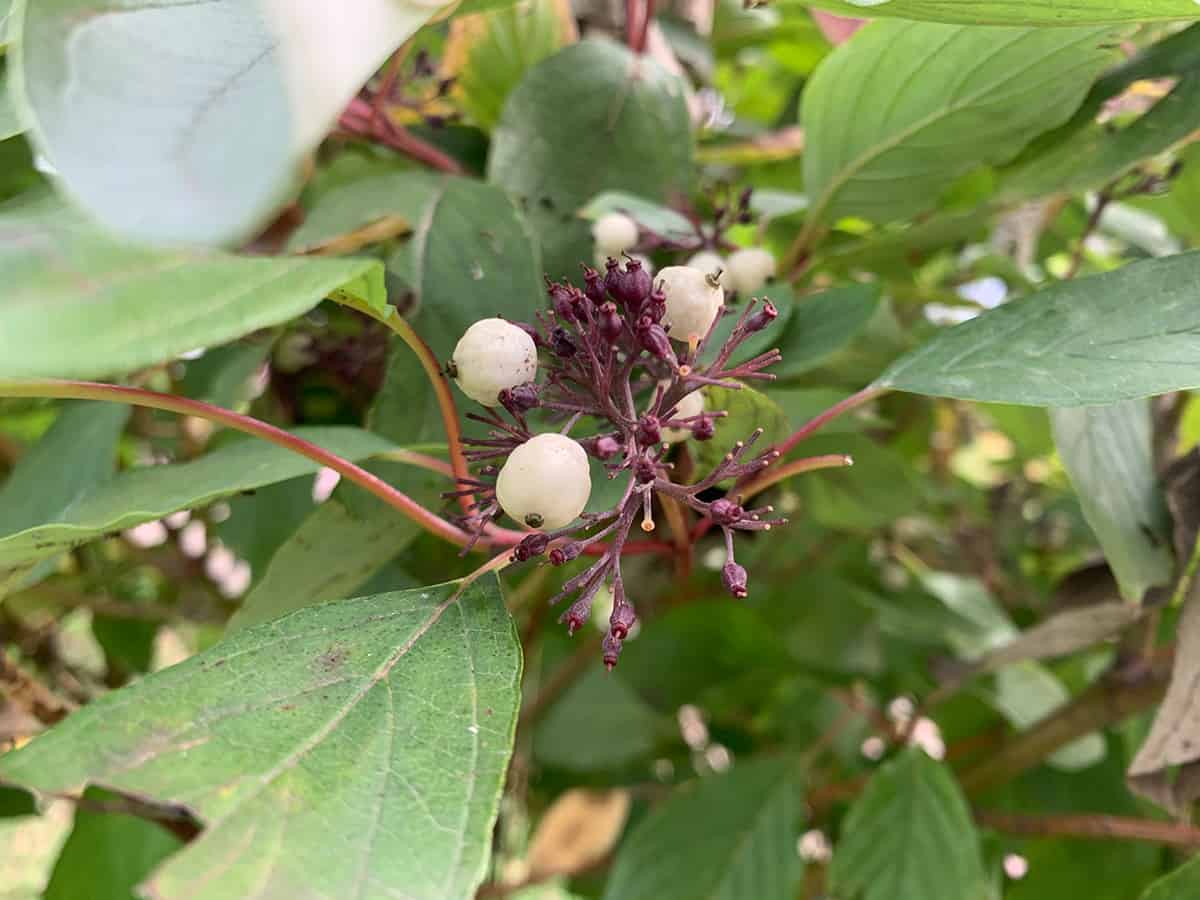
- Botanical name: Cornus racemosa
- Common names: Gray Dogwood, Panicle Dogwood
- Plant family: Cornaceae
- USDA hardiness zone: 4 – 8
- Mature height: 10 to 15 feet
- Mature spread: 10 to 15 feet
This is a deciduous shrub producing blue-green foliage and white flowers followed by white berries.
Red Osier Dogwood
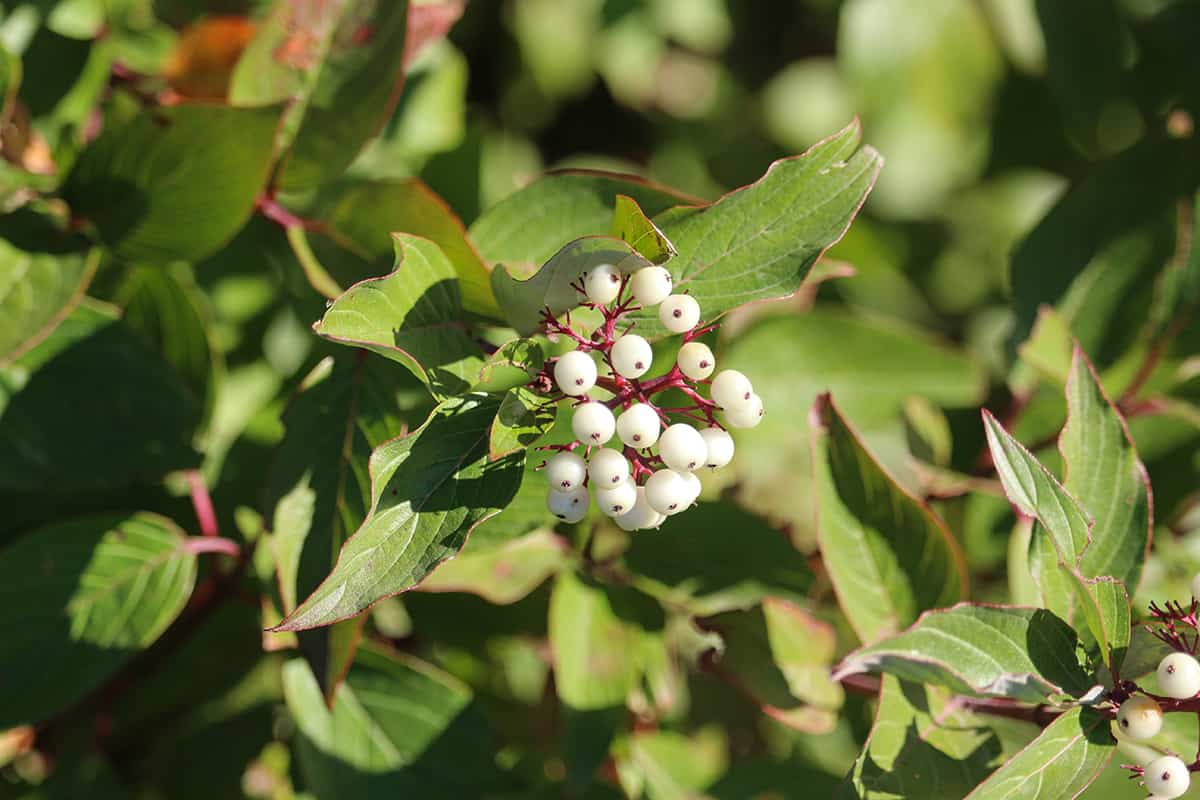
- Botanical name: Cornus sericea
- Common names: Red Osier Dogwood, Creek Dogwood, Redstem Dogwood, American Dogwood, Red Willow
- Plant family: Cornaceae
- USDA hardiness zone: 3 – 8
- Mature height: 6 to 9 feet
- Mature spread: 8 to 12 feet
This is a vigorously growing shrub with bright red stems on display throughout winter.
Identifying Dogwood Trees
Dogwood trees are easiest to identify in spring or summer when they are in flower or in fruit. Dogwoods produce striking flowers in shades of white or pink, though in fact, these are actually leaf bracts that have the appearance of petals. Dogwood flowers are made up of a central cluster of tiny green flowers, and these are surrounded by four sturdy leaf bracts which are rounded and come to a point at the tip.
The flowers will develop into fruits that dangle from long stems like cherries. They are round, usually pink or red, and have skin that looks much like that of a strawberry. The foliage of dogwood trees can vary in color but will usually always be ovate in shape. Some dogwoods have mid or dark-green leaves, while others are variegated. The variegated types of dogwoods usually have darker colors at the center and lighter colors, such as yellow or cream, around the edges of the leaves.
If you are trying to identify a dogwood tree in the fall, then look out for brightly colored leaves in shades of purple or red. There is one exception to this, which is variegated dogwood trees that don’t take on fall foliage colors. All dogwood trees are deciduous, which means they shed their leaves in fall or winter.
You can identify a winter dogwood by the lack of leaves and the gray-mottled bark with an alligator skin pattern. Dogwood shrubs can have brightly colored stems in winter, which are usually vivid shades of red, though some species will have lime-green stems.
Dogwood Tree Care Guide
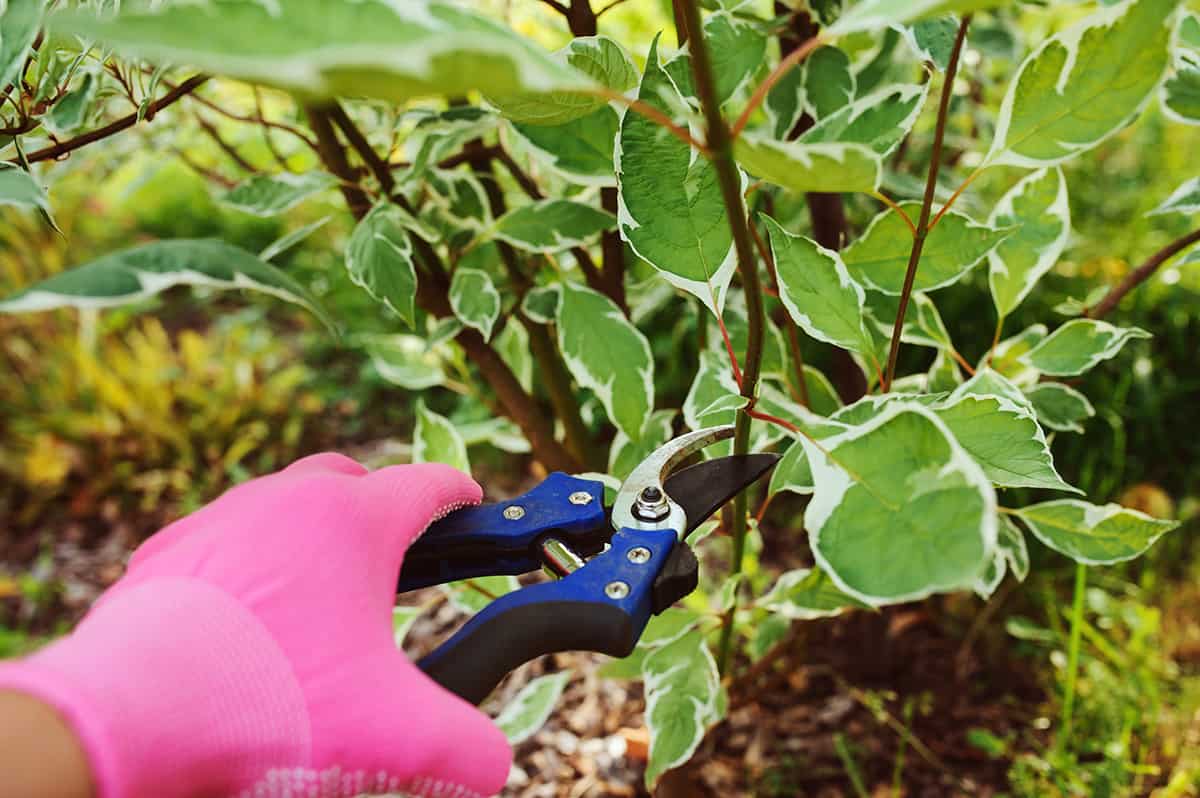
There are a number of species of dogwood, and each of them has their own specific care needs. However, for the most part, many types of dogwood share similar care requirements when it comes to light exposure, soil types, and moisture preferences.
- Light: Full sun to partial shade
- Soil: Well-draining
- Water: Average moisture
- Hardiness: USDA zones 2 – 9
Light
Most dogwood trees will thrive in partial shade. However, there are particular species that prefer different types of exposure. The White Dogwood, the Gray Dogwood, and the Japanese Dogwood will perform best in either full sun or partial shade, and the Gray Dogwood can also withstand full shade, though this isn’t preferable.
As dogwood trees are small in stature, they typically grow as understory trees in their natural habitats. This means they tend to be accustomed to growing beneath the dappled shade of taller species, so this is the type of light exposure you should try to replicate when growing dogwood trees in the garden.
You can achieve this by planting dogwoods beneath taller trees or positioning them in the corner of the garden where they will be shaded during the afternoon by a fence, wall, or nearby building. For dogwoods grown in warmer climates, dappled shade is usually preferable over full sun to prevent them from getting too hot. Try to ensure dogwoods of any species have access to at least 4 hours of direct sun each day.
Soil
Dogwood trees thrive in well-draining soils which are kept evenly moist. Most types of dogwood prefer growing in soils that are fertile and rich in organic content. However, this isn’t essential. Most dogwood trees will thrive in any type of soil, even poor soils, as long as they are able to drain well and are not allowed to dry out.
Soils can be amended with grit and sand to improve their drainage, which will prevent root rot from becoming an issue when the trees are generously watered. Some dogwood trees will tolerate periods of drought, such as the White Dogwood and Japanese Dogwood, however, consistently moist soils are preferable. Most dogwood trees will perform best with cool root systems, so mulching over the soil in summer can be beneficial.
Water
Dogwood trees like to be grown in soils that are consistently moist, which is why a well-draining soil is important. If the soil cannot drain well, then generously watering the dogwood will result in waterlogged, soggy soils, and this can lead to root rot. There are some dogwood species that can tolerate wet soils, such as the White Dogwood and the Gray Dogwood.
There are also some dogwood species that will tolerate periods of drought, such as the White Dogwood, the Japanese Dogwood, and the Pacific Dogwood. These trees can sustain themselves through short dry periods, but they will perform best when soil is kept consistently damp or moist.
Most dogwood species should be watered generously from spring through summer, and they will survive on rainfall through fall and winter. In climates that experience minimal rainfall through the cooler months, supplemental irrigation is recommended.
Temperature
Most dogwood trees thrive in temperatures that are neither very hot nor very cold. The Flowering Dogwood and Pink Dogwood are both suitable for growing in USDA hardiness zones 5 to 9, while the Japanese Dogwood is not quite as tolerant of warmer temperatures, being suitable for growing in USDA hardiness zones 5 to 8.
The Pacific Dogwood is best suited to warmer climates, growing well in USDA hardiness zones 7 to 9. If you want a dogwood tree for a cooler climate, opt for the White Dogwood, which is one of the most cold-hardy dogwoods that can be grown in USDA hardiness zones 2 to 7. The Red Osier Dogwood is also quite cold-hardy, being suitable for growth in USDA hardiness zones 3 to 8.
Humidity
Dogwoods do not need high levels of humidity to thrive, but many dogwoods prefer moist and damp conditions which typically have a higher moisture content in the air.
Fertilizer
Most dogwood trees thrive in fertile soils, so the use of fertilizer is beneficial. You can also improve the fertility of the soil by amending it with the addition of well-rotted manure or organic compost. Work these into the top few inches of soil, and the nutrients will seep down into the depths of the soil when it rains or when the tree gets watered. This will increase the nutrient quality of the soil more gradually compared with fertilizer treatments.
You can also add compost to the bottom of a dug hole before you plant the dogwood tree in it, creating a nutrient-dense spot right next to the root ball. If your soil is poor, fertilizer can give it a boost to help dogwood trees thrive. Use all-purpose fertilizer through spring and summer, applying it to the soil around the tree and avoiding contact with the trunk.
Many dogwood trees can tolerate poor soils, such as the White Dogwood, and Pagoda Dogwood. However, they perform best in fertile soils. Dogwood trees that rely on fertile soils include Flowering Dogwood and Pacific Dogwood.
Pests and Diseases
Most types of dogwood are relatively free from diseases and pest infestations, though they can fall victim to common pests that affect a wide range of trees, including scale insects and sawflies. One problem among dogwood trees is fungal diseases because fungus thrives in moist environments, and most dogwoods also thrive in moist environments.
While there is no way to ensure fungal disease does not occur, you can lower the likelihood of this being a problem by ensuring good airflow and circulation between the branches of your dogwood tree. This will help to prevent leaves from staying wet for too long after rainfall and help the sun penetrate the lower branches. If fungal disease does become a problem, this is best treated with a chemical fungicide. In severe cases, you may need to cut down the dogwood tree and dispose of it to prevent the spread to nearby trees and plants.
Uses for Dogwood Trees
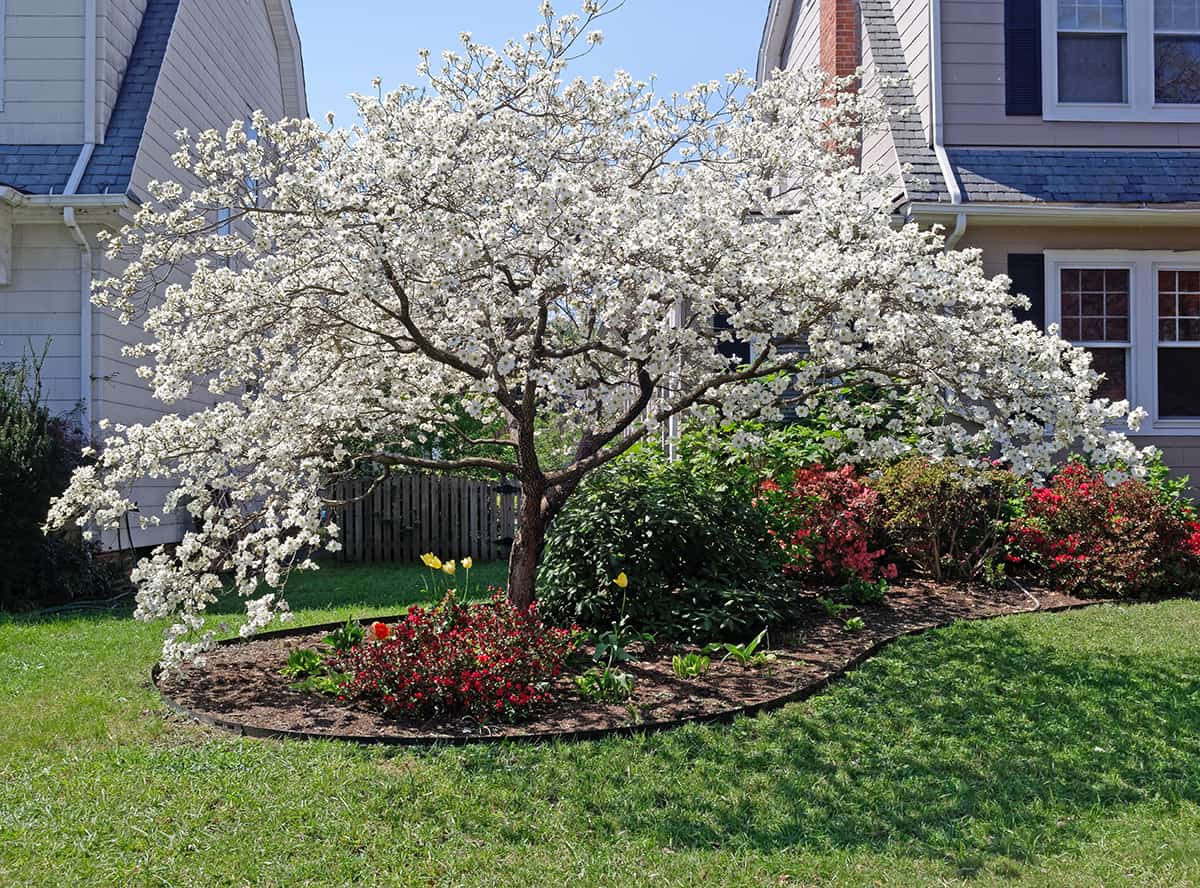
Privacy screen
Many types of dogwood can be grown as small trees or large shrubs. If you want to create a natural privacy screen around your garden, then White Dogwood is a good choice because it has a spreading nature that will form dense thickets. In winter the privacy screen will be less effective due to the deciduous nature of the dogwood. However, it will remain attractive all year round. In summer, the dense leaves create a perfect privacy screening.
Erosion control
White Dogwood can be used for erosion control on slopes and banks because it has a vigorous and extensive root system that can help to hold the ground together.
Summer shade
Some dogwood trees are ideal for creating shade in the summer, especially in smaller gardens that may not accommodate larger species of trees. Flowering Dogwoods work really well for this purpose because they have a spread of up to 30 feet, providing a large shaded area in summer. The densely branched tree will be covered with flowers in spring and leaves through summer and fall, for an attractive source of shade for much of the year. Japanese Dogwood also works well as a source of summer shade for the same reasons.
Attract wildlife
Dogwood trees are great for attracting wildlife to the garden. The flowers are popular among butterflies and other pollinators, while the subsequent fruits are a source of food for birds and squirrels. As an added bonus, dogwood trees are resistant to deer and rabbits.
Medicinal properties
Dogwoods have long been used for medicinal purposes. Native Americans used the bark of the tree to make a tea that was used to treat fever and malaria. The inner bark is rich in tannins, which have a bitter taste but are useful as a medicinal alternative to quinine. The tea made from the bark of the dogwood tree was widely used during the American Civil War as a treatment for diarrhea, colds, indigestion, and pneumonia.
Winter color
Dogwood trees are loved for their ability to bring interest to the usually dull winter landscape. White Dogwood and Red Osier Dogwood are famed for their bright red stems that become even more vivid during the winter, adding intense color to the garden at a time when many plants lack vibrance.
Some dogwood trees, such as the Japanese Dogwood, have unusual bark that can add interest to the winter landscape. When the leaves drop from the trees in fall, the mottled gray bark is revealed which takes on the pattern of alligator skin as the tree becomes more mature. Some dogwoods also feature exfoliating bark which adds another dimension to the winter garden.
Year-long interest
One of the main reason gardeners choose to grow dogwoods in their gardens is for their ability to provide year-long interest in the landscape. The trees bloom heavily in late spring, putting on a profuse display of flowers in shades of pink or white. Through summer, the densely branched dogwoods are covered in attractive mid-green to dark green leaves, with some cultivars offering variegated foliage with touches of yellow or cream around the leaf margins.
Summer also sees the development of round, strawberry-like fruits which dangle on long stems like ornaments decorating the tree. As fall approaches, the foliage of the dogwood turns to vibrant shades of red, orange, yellow, or purple, adding intense color to the landscape. The tree then sheds the leaves as winter arrives, revealing the brightly colored stems of some dogwoods, and the patterned bark of others. The fruits of the tree can also persist on the dogwood into winter if they haven’t been devoured by local wildlife.
Dogwood Tree Size
Dogwoods are small trees or large shrubs that are ideally suited for compact to medium-sized gardens. They typically grow to heights of between 15 and 30 feet, with a similar-sized spread, though the Pacific Dogwood can get taller at a maximum height of 40 feet.
Dogwood trees can be grown in pots, which makes them useful for positioning on the patio, and in this case, their growth will be reduced to around half their ultimate size.
